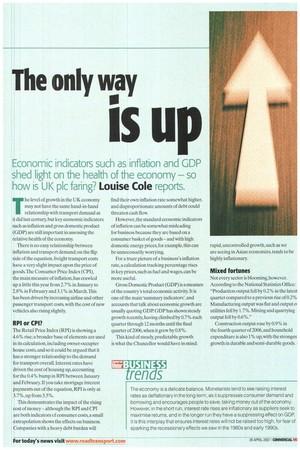The only way
Page 51

If you've noticed an error in this article please click here to report it so we can fix it.
'sup
Economic indicators such as inflation and GDP shed light on the health of the economy — so how is UK plc faring? Louise Cole reports.
The level of growth in the UK economy may not have the same hand-in-hand relationship with transport demand as it did last century, but key economic indicators such as inflation and gross domestic product (GDP) are still important in assessing the relative health of the economy.
' There is no easy relationship between inflation and transport demand; on the flip side of the equation, freight transport costs have a very slight impact upon the price of goods.The Consumer Price Index (CPI), the main measure of inflation, has crawled up a little this year from 2.7% in January to 2.8% in February and 3.1% in March.This has been driven by increasing airline and other passenger transport costs, with the cost of new vehicles also rising slightly.
RPI or CPI?
The Retail Price Index (RPI) is showing a 4.6% rise; a broader base of elements are used in its calculation, including owner-occupier house costs, and so it could be argued that it has a stronger relationship to the demand for transport overall. Interest rates have driven the cost of housing up, accounting for the 04% bump in RPI between January and February. If you take mortgage interest payments out of the equation, RPI is only at 3.7%, up from 3.5%.
This demonstrates the impact of the rising cost of money although the RPI and CPI are both indicators of consumer costs, a small extrapolation shows the effects on business. Companies with a heavy debt burden will find their own inflation rate somewhat higher, and disproportionate amounts of debt could threaten cash flow.
However, the standard economic indicators of inflation can be somewhat misleading for business because they are based on a consumer basket of goods and with high domestic energy prices, for example, this can be unnecessarily worrying.
For a truer picture of a business's inflation rate, a calculation tracking percentage rises in key prices, such as fuel and wages, can be more useful.
Gross Domestic Product (GDP) is a measure of the country's total economic activity. It is one of the main 'summary indicators', and accounts that talk about economic growth are usually quoting GDP GDP has shown steady growth recently, having climbed by 0.7% each quarter through 12 months until the final quarter of 2006, when it grew by 0.8%.
This kind of steady, predictable growth is what the Chancellor would have in mind: rapid, uncontrolled growth, such as we are seeing in Asian economies, tends to be highly inflationary.
Mixed fortunes
Not every sector is blooming, however. According to the National Statistics Office: "Production output fell by 0.2% in the latest quarter compared to a previous rise of 0.2% Manufacturing output was flat and output utilities fell by 1.7%. Mining and quarrying output fell by 0.6%."
Construction output rose by 0.9% in the fourth quarter of 2006, and household expenditure is also 1% up, with the stronger growth in durable and semi-durable goods.






















































































































































































